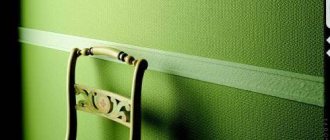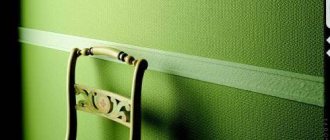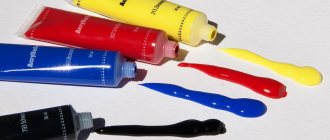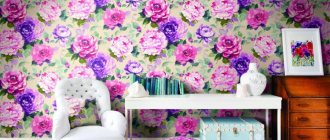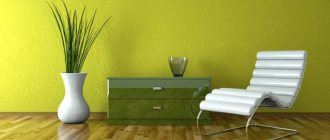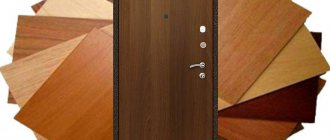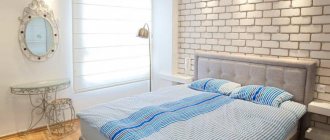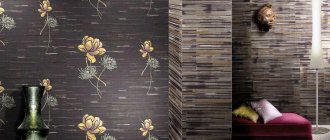Standard houses, identical furnishings, renovations “just to make sure they are clean” – all this is a thing of the past. Now any person has the opportunity to organize their life and decorate their apartment not only based on their budget, but also taking into account their own aesthetic taste. Manufacturers offer a lot of different materials to implement an interesting design, but only designs made from liquid wallpaper can add originality to the interior and make it unique. With even a little artistic skill, you can easily create a museum-quality masterpiece at home.
Features of drawings with liquid wallpaper on the wall
The practical capabilities of the composition have made this type of interior creativity extremely popular, and its plasticity and ease of use have expanded the scope of its application in design: now you can create entire pictures that will delight you and your household for years. In addition to the above, wallpaper for walls has a number of advantages over other finishing materials:
- safe for health;
- high degree of heat and sound insulation;
- the possibility of applying the mass to the working surface with a tool or by hand;
- the relief is smoothed with a rubber float, and the depth of the volumetric composition is formed with a spatula or knitting needles;
- minimal wall preparation required;
- ease of correcting mistakes (just moisten the unnecessary fragment and remove it with a spatula);
- the joints between the layers of material are not visible;
- independent preparation allows you to create the shade that is needed for the idea;
- For creativity, you can use complex, curved surfaces of even a small area.
Before work, old coatings are removed from the walls, deep defects are puttied and surfaces are primed. Next, apply a background layer and wait until it dries completely. Then they begin to create the drawing.
In this case, the main condition for obtaining a high-quality image will be the obligatory observance of time for drying each layer. The work is, of course, painstaking, but the result is worth it.
Microclimate
Liquid wallpaper is less capricious when applied, so completely blocking the space is not so important for them. You can leave the window slightly open, but it is important to ensure that there are no drafts.
The optimal temperature will be 17-25 degrees. In a room where the thermometer does not rise above 10 degrees, pasting is not carried out. But heating devices should not be used either.
Guidelines for creating images
Drawings on liquid wallpaper look great in any room, and their environmental safety allows them to be used even in a nursery. When choosing a theme, proceed from the concept of the room and style direction:
- in the bedroom, calm, relaxing landscapes in neutral shades are preferred;
- It is better to discuss the design of the nursery with the child (usually cartoon characters, cars);
- geometric shapes are most often used to decorate the living room;
- in the kitchen they draw still lifes, silhouettes of dishes, and the city in perspective.
Having decided on the idea, create a sample of the future painting and select colors for the composition.
Decorating walls with images is possible in several ways:
- using a stencil;
- drawing the outline of the sketch immediately on the surface;
- projection of an outline using a lamp and glass.
Choose any method to realize your idea, taking into account your artistic skills.
For work, purchase a white mixture, which you will paint in the desired colors during the process with pigments.
Don’t immediately take on complex compositions; start gaining experience with two-color patterns or geometric shapes (diamonds will look great in the living room).
What you will need
To create a pattern with liquid wallpaper, in addition to the desire to create, you will need:
- trowel for applying the mass;
- grater for smoothing the relief;
- roller to add structure to the composition;
- spatula or spatula for distributing the composition;
- ready-made mixture (read the instructions carefully: it takes 6-7 hours to activate the components);
In addition, prepare felt-tip pens or wax crayons; you will need them to outline the contour of the dried design.
How to apply a design using a stencil
Transferring an image using a ready-made form is the most convenient way; it is suitable for people who do not have artistic skills. With its help, they create unusual three-dimensional drawings or flat paintings. You can make stencils for liquid wallpaper with your own hands or purchase ready-made ones.
The main thing when working with stencils is reliable fixation to the wall, so when purchasing, choose templates with an adhesive base.
What do you need for this?
To work, in addition to tools and ready-made mass, you need to stock up on masking tape and purchase or make a stencil. To do this, the selected image is printed and transferred in its original size onto a thick sheet of cardboard. Then it is carefully cut out along the contour and attached to the wall using paper adhesive tape.
Drawing "Curls"
Step-by-step instruction
Drawings on liquid wallpaper require preliminary preparation of the surface, which includes cleaning, priming and applying a background. After the time required for drying has passed, begin creating the image through the stencil:
- secure the template to the surface;
- Apply a layer of mass with a spatula so that the colors involved in the composition do not touch;
- smooth the relief with a damp grater to create a flat picture;
- applying the next layer is possible only after the previous one has dried;
- finishing work consists of drawing contours and a protective coating.
The structure is added to the design using a roller with special attachments, but only after the work has dried. When working with volumetric elements, layer by layer is applied, forming a bulge and maintaining the exposure time. The relief is created using grooves, pressing them with knitting needles, a spatula or a spatula.
Video
Watch video tutorials on decorating the interior of an apartment with drawings on the walls:
Security measures
Before you proudly declare: “Today we apply liquid wallpaper ourselves,” you should take care of the safety of future work and nearby objects.
The wiring must be de-energized. It is better to seal sockets, switches, window and door frames with masking tape, and cover the floor and furniture with film. If the repairmen are confident in their accuracy, this point can be skipped, especially since the mass retains its plasticity for a long time and is easily washed off with water.
How to make a drawing using a template and sketch
With drawing skills, you can create more complex paintings using multiple colors. To do this, make a sketch on the glass, project it onto the wall using a lamp, and trace the resulting outline.
Step-by-step execution of work
Before transferring the template to the surface, perform the following steps:
- dilute the required amount of composition;
- we prepare the wall, but do not apply the background;
- we reflect the drawing using the chosen method, marking the colors on individual elements;
- using a spatula, apply a layer 3 mm thick, without going beyond the contour and without connecting the borders of the colors;
- level the relief with a damp grater;
- dry each layer (you can speed up the process with a hairdryer);
- close the boundaries between different shades and apply the main background.
Defects (a layer of the wrong shade, going beyond the outline) can be eliminated with a damp cloth or spatula.
Artistic paintings with liquid wallpaper
In this case, you apply the image to the wall yourself, carefully drawing out all the details of the future picture from liquid wallpaper with a pencil. The execution steps here are the same as when working with a template. You should start by applying the color that is most in the drawing. Next, fill in the adjacent areas and, after the decorative canvas has dried, close the voids between the borders and apply the main background.
The main color of the design (background) is applied last.
Tools
To apply liquid wallpaper you will need to prepare a special and familiar tool. They will be a spatula and a trowel for leveling the surface, a container for diluting the mass, and a measuring cup for water.
The thin mixture can be applied with rollers; for finishing large and very large rooms you will need a cartouche gun and a compressor for it.
Original drawing options
The real highlight of the interior will be the thematic design, which you will transfer to the surface in any convenient way. You can even decorate the ceiling with liquid wallpaper using sketches of ornaments around the perimeter, and beautiful silk panels will emphasize the luxurious Baroque style in the living room or bedroom.
Flowers
Perhaps one of the best wall decorations are images of a plant nature. An exquisite three-dimensional flower or a whole bouquet is an excellent option for decorating the wall of a bedroom or living room. When creating, you can experiment with shades, placing layers on top of each other, mixture additives and relief.
Trees
Even a person with school drawing skills can draw a tree using a stencil. An elegant sakura branch is considered a classic of the genre. By adding low wicker furniture and floor vases to the interior, you will get a Japanese-style living room design.
Natural landscapes
In order to apply a drawing on a wall with a complex theme, you need to have artistic abilities. Making landscapes is a painstaking and time-consuming job, but the result of your efforts will cause white envy among your guests and will be an excellent addition to the interior in the Provence style.
Geometry
Circle, rhombus, square, rectangle - all this can be transferred to the wall using a stencil and done with a minimum number of colors. For originality, use a combination of shapes, highlight them with shades, relief, in general, fantasize with geometry as you like: it is impossible to spoil it.
Paintings
An interesting solution for a living room in a classic style would be to create a picture using silk liquid wallpaper. This option can be used as a separate decorative element on any surface, if you separate it from the main background with a wooden frame.
Patterns and curls
It is more convenient to draw patterns and curls using a stencil: basically, it is a repeating fragment. Floral designs look great in a bedroom or kitchen.
Animals and insects
Drawing a horse or a butterfly is not difficult: use the template and sketch technique. You can easily color the resulting outline together with your child and decorate the children’s room with the picture.
Preparing for work
Tools
The technology of applying liquid wallpaper is good because it does not require the use of complex and expensive equipment. For surface finishing the following can be used:
Metal grater for smoothing
- sprayer (for professional treatment of large areas);
- spatulas with a width of 20 to 60 cm;
- trowels;
- painting knives.
Sprayer for treating large areas
And yet, more often when decorating walls with your own hands using this material, graters are used - metal or plastic. And the best tool is a transparent grater made of plastic or plexiglass: its surface allows you to control the quality of the coating being formed and quickly make adjustments.
Clear plastic iron
In addition to hand tools, we will need:
- containers for soaking liquid wallpaper;
- spray bottle for moistening surfaces;
- rack, scaffolding or table for working at height.
As for workwear, you can limit yourself to a hat (so you don’t have to wash your hair off the glue) and gloves. Liquid wallpaper does not contain volatile toxins, so working with it will be completely safe.
Surface
Before starting work, you need to prepare the base for applying liquid wallpaper. This material will only adhere firmly to a dry and clean surface that is not prone to peeling. This is why even an initial inspection of the wall will tell you whether the coating can be applied - or whether cleaning/spackling/priming is necessary.
The preparatory work technology will be as follows:
- First, we remove from the wall all the objects installed on it - shelves, brackets, cornices, etc.
- Those structural elements that cannot be dismantled (window sills, moldings, etc.) are sealed with masking tape or covered with polyethylene. This will prevent the adhesive from getting in.
You cannot apply liquid wallpaper to wallpaper made of paper, vinyl or non-woven fabric - there is a high risk of peeling. So you have to shoot!
- We remove wallpaper and other decorative coverings from the wall. Liquid wallpaper cannot be applied to either paint or whitewash - it will peel off along with the decorative layer.
- We tap the plaster to detect defects. We clean the identified areas with poorly adhering coating to the base, after which we re-level them.
- We treat areas affected by fungus with antiseptics.
Antiseptic treatment avoids stains on wallpaper
To understand what this decorative material can be applied to and how to prepare different substrates, study the following table:
| Where do we apply it? | How do we cook? |
| On plaster or concrete |
|
| On drywall |
|
| On a wooden wall or partition made of chipboard/MDF/OSB |
|
| On metal surfaces |
|
We putty and prime the walls
We coat wood and metal with this composition.
The question of whether it is necessary to putty walls under liquid wallpaper is debatable. The need for this operation depends on the condition of the surface. This decorative material does not require a perfectly flat base, so if the unevenness does not exceed 1 - 1.5 mm, then putty can be abandoned. A layer of fiber coating will perfectly mask all defects.
You need to putty with high quality, but “without fanaticism” - minor defects will be hidden by the finish
Primer is another matter. The fact is that the most effective method of applying liquid wallpaper involves introducing a large amount of water into its composition (up to 2 liters per 1 m2).
If you do not protect the base with penetrating soil, then as a result of moisture there is a risk of the putty or plaster peeling off. And walls made of wood, wood boards or plasterboard can simply swell as a result of getting wet.
White primer creates a neutral background for a thin-layer decorative coating
It is very important that the soil is white or transparent. The use of tinted primers can lead to unwanted coloration of the liquid wallpaper base.
Composition for application
If you plan to do the finishing yourself, then it is worth studying how the volume of material is determined and how to prepare the composition for treating walls yourself. Let's start with the first point:
- We determine the area of all surfaces that will need to be decorated. To do this, multiply the perimeter of the room by its height, and subtract the area of window and door openings from the resulting value.
The thicker the layer, the greater the consumption per unit area
- We divide the calculated area by the material consumption (this value may differ depending on the specific brand of coating). On average, to finish one square meter you need from 200 to 400 grams of dry matter, so a standard kilogram bag is enough for 3 to 4 squares.
- Having determined the mass, we buy the amount of dry material we need. I strongly recommend taking one more package than you need according to calculations - and there will be a reserve in case of defects, and if necessary, there will be more than enough to repair the damaged area.
Now - preparing the material for application:
Dry base: it can be immediately soaked in water
- We spread a clean sheet of polyethylene on the floor. Pour the dry base onto the polyethylene, including the adhesive component, polymers and fiber filler. Stir until completely homogeneous.
This work is best done with gloves. For additional protection, use a respirator (at least a primitive “Petal” and goggles).
- Pour clean water into a container with a wide neck (bucket, trough). The optimal water temperature is 40 – 500C. Add the dry component and mix by hand until the lumps with the dry core disappear completely.
You can add glitter to the water - this way they will be more evenly distributed throughout the composition.
It is advisable to mix some brands of liquid wallpaper using a drill with a mixer attachment. For others, such intense exposure is undesirable - the color structure may be disrupted. To figure out how to do the right thing, carefully study the instructions from the manufacturer.
Some compositions need to be mixed only with a mixer
- Cover the container with the mixed composition with polyethylene and leave the glue to swell. Soaking time varies between brands and can range from 2 to 8 hours.
Mixing the composition manually
- The swollen composition under the film retains its working qualities for at least a day, maximum 4-5 days. Repeated soaking is undesirable, since due to partial hardening of the glue and polymers, the strength of fixation to the surface will be greatly reduced.
Photo ideas for drawings on the walls with liquid wallpaper
Look at the photos of the use of images in design:
Tyutyunnikov Dmitry
Article verified by a decorative finishing specialist
